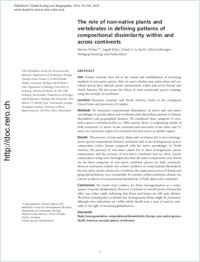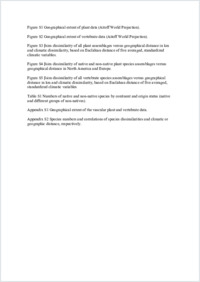The role of non-native plants and vertebrates in defining patterns of compositional dissimilarity within and across continents
- Winter, Marten UFZ Helmholtz Centre for Environmental Research, Department of Community Ecology, Halle (Saale), Germany - Ecology and Evolution Unit, Department of Biology, University of Fribourg, Switzerland
- Kühn, Ingolf UFZ Helmholtz Centre for Environmental Research, Department of Community Ecology, Halle (Saale), Germany
- Sorte, Frank A. La Department of Ecology and Evolutionary Biology, Yale University, New Haven, USA
- Schweiger, Oliver UFZ Helmholtz Centre for Environmental Research, Department of Community Ecology, Halle (Saale), Germany
- Nentwig, Wolfgang Community Ecology, Zoological Institute, University of Bern, Switzerland
- Klotz, Stefan UFZ Helmholtz Centre for Environmental Research, Department of Community Ecology, Halle (Saale), Germany
-
15.03.2010
Published in:
- Global Ecology and Biogeography. - 2010, vol. 19, no. 3, p. 332-342
Biotic homogenization
compositional dissimilarity
Europe
non-native species
North America
vascular plants
vertebrates
English
Aim Human activities have led to the spread and establishment of increasing numbers of non-native species. Here we assess whether non-native plant and vertebrate species have affected species compositions within and across Europe and North America. We also assess the effects of intra-continental species exchange using the example of vertebrates.Location European countries and North America (states in the contiguous United States and provinces of Canada).Methods We measured compositional dissimilarity of native and non-native assemblages of vascular plants and vertebrates and related these patterns to climatic dissimilarity and geographical distance. We considered three categories of non-native species (introduced after ad 1500), namely: those (1) originating outside of both continents, (2) native to one continent and non-native to the other, and (3) native in a particular region of a continent but non-native in another region.Results The presence of non-native plants and vertebrates led to more homogeneous species compositions between continents and to less homogeneous species composition within Europe compared with the native assemblages. In North America, the presence of non-native plants led to more homogeneous species compositions and the presence of non-native vertebrates had no effect. Species compositions being more homogeneous than the native composition were found for the three categories of non-native vertebrate species for both continents. Between continents, climate was a better predictor of compositional dissimilarity for non-native plants, whereas for vertebrates the explanatory power of climate and geographical distance were comparable. By contrast, within continents, climate was a better predictor of compositional dissimilarity of both plants and vertebrates.Conclusions We found clear evidence for biotic homogenization as a consequence of species displacement. However, in relation to overall species richness this effect was rather small, indicating that floras and faunas are still quite distinct. Therefore, claiming that we already face homogeneous biotas might be premature, although clear indications are visible which should raise a note of caution, especially in the light of increasing globalization.
- Faculty
- Faculté des sciences et de médecine
- Department
- Département de Biologie
- Language
-
- English
- Classification
- Biological sciences
- License
-
License undefined
- Identifiers
-
- RERO DOC 17994
- DOI 10.1111/j.1466-8238.2010.00520.x
- Persistent URL
- https://folia.unifr.ch/unifr/documents/301493
Other files
Statistics
Document views: 143
File downloads:
- pdf: 235
- Supplementary material: 138

